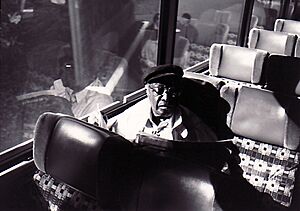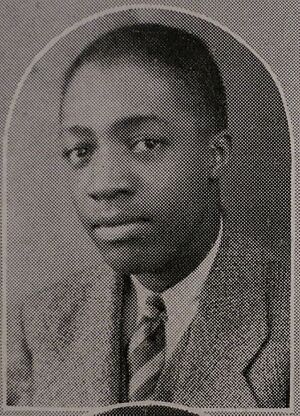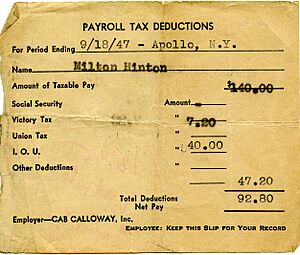Milt Hinton facts for kids
Quick facts for kids
Milt Hinton
|
|
|---|---|

Milt Hinton aboard the SS Norway (1988)
|
|
| Background information | |
| Birth name | Milton John Hinton |
| Born | June 23, 1910 Vicksburg, Mississippi, U.S. |
| Died | December 19, 2000 (aged 90) Queens, New York |
| Genres | Traditional jazz, swing, pop |
| Occupation(s) | Musician, photographer, educator |
| Instruments | Double bass |
| Years active | 1920s–1990s |
| Labels | CBS, Bethlehem, Victor, Black & Blue, Chiaroscuro |
Milton John Hinton (June 23, 1910 – December 19, 2000) was an American musician and photographer. He was famous for playing the double bass in jazz music.
Many people called him the "Dean of American jazz bass players." He had several nicknames, like "Sporty," "Fump," and "The Judge." Milt Hinton recorded music for over 60 years. He played mostly jazz but also many other types of music. He was a very busy session musician, meaning he played on many recordings for different artists.
He was also a talented photographer. His photos helped show what American jazz was like during the 20th century.
Contents
Milt Hinton's Life Story
Early Years in Mississippi (1910–1919)
Milt Hinton was born in Vicksburg, Mississippi, in the United States. He grew up with his mother, his grandmother, and two of his aunts. His childhood in Vicksburg was very difficult. His family was very poor, and he experienced a lot of racism.
Growing Up in Chicago (1919–1935)
In late 1919, Milt and his family moved to Chicago, Illinois. This move gave him many new chances. In Chicago, Milt saw that not all African-Americans were poor. He also found a lot of music, both live and on the radio. He heard famous musicians like Louis Armstrong and Duke Ellington.
Music was always around in his home. His mother and other relatives often played the piano. For his 13th birthday in 1923, Milt received his first instrument, a violin. He studied the violin for four years. He also went to concerts every Sunday to hear orchestras with famous soloists.
After high school, Milt went to college for two years. During this time, he started working as a freelance musician in Chicago. He played with many great artists. Milt soon taught himself to play the double bass. There were more jobs for bass players than for violinists. His first steady job was in 1930, playing tuba and later double bass in Tiny Parham's band. He made his first recording on the tuba in 1930. After college, he decided to become a full-time musician. From 1932 to 1935, he played regularly with violinist Eddie South.
The Cab Calloway Years (1936–1950)
In 1936, Milt Hinton joined the Cab Calloway Orchestra. He was supposed to be a temporary player, but he ended up staying with Calloway for over 15 years! The band played at the famous Cotton Club in New York City for six months each year. During this time, Milt also recorded with stars like Benny Goodman and Billie Holiday. He even recorded what might be the first bass solo song, "Pluckin' the Bass," in 1939.
Milt was often on the radio with Calloway's band. These shows made the band famous across the country. They also taught listeners about "jive talk," which Cab Calloway even put into a dictionary!
Calloway's band had many amazing musicians, including Dizzy Gillespie. Milt said that Dizzy Gillespie taught him new ways to play music. These ideas later became part of a new style called bebop.
In 1939, Milt met Mona Clayton. They got married a few years later and stayed together for the rest of Milt's life. Their only child, Charlotte, was born in 1947. Mona often traveled with the Calloway Orchestra. She helped the musicians manage their money and was a trusted friend. Later, the Hintons bought a house in Queens, New York, where they lived for many years.
Mona was very important to Milt's career. She managed the family's money and kept track of Milt's work. She also scheduled interviews and drove him to his gigs. Mona was well-respected in the jazz world. Many people saw Milt and Mona as role models.
After Cab Calloway (1950–1954)
By 1950, music tastes had changed, and Cab Calloway's big band became smaller. Milt stayed with Calloway's smaller group until 1952. After that, Milt became a freelance studio musician in New York City. At first, work was hard to find, and Milt worried about making a living. He played in many clubs and restaurants. He also played with famous musicians like Count Basie.
In 1953, Milt joined Louis Armstrong's band for a year-long tour. It was a tough choice because it meant being away from his family. But the steady pay and chance to play with Armstrong were too good to pass up. He toured Japan with Armstrong. In 1954, Milt left Armstrong's band to join a TV show house band in New York.
In the Studios (1954–1970)
For about 20 years, Milt played regularly on many radio and TV shows. These included shows hosted by Jackie Gleason and Patti Page. Milt liked this work because he was paid by the show and had free time for other recordings.
His main work during this time was in recording studios. Milt was one of the first African-American musicians to be hired regularly for studio work. From the mid-1950s to the early 1970s, he played on thousands of jazz and pop records. He also played on hundreds of jingles and movie soundtracks. He often played three recording sessions a day! He recorded with everyone from Billie Holiday to Paul McCartney and Frank Sinatra to Barbra Streisand. Milt said he probably played for almost every popular artist back then.
In the mid-1950s, he often worked with Hank Jones (piano), Barry Galbraith (guitar), and Osie Johnson (drums). They were known as the New York Rhythm Section. They played on hundreds of recordings together.
After the Studios (1970–2000)
By the late 1960s, studio work slowed down. So, Milt started doing more live performances. He played regularly in clubs and went back on tour with artists like Paul Anka and Barbra Streisand. From the 1960s to the 1990s, he traveled all over the world, including Europe, Japan, and the Soviet Union.
In 1968, he joined a group called Professionals Unlimited (later the New York Bass Violin Choir). This was a group of bass players who performed together.
Milt also taught for almost 20 years as a visiting professor at colleges like Hunter College. He taught jazz workshops. During this time, he also played at many jazz festivals and on jazz cruises. He played at the very first Newport Jazz Festival in 1954 and was a regular there for decades.
By the 1990s, Milt was seen as a wise and respected jazz elder. He received many important awards. He earned honorary doctorates from several colleges. He also won the Living Treasure Award from the Smithsonian Institution. In 1993, he received the very important National Endowment for the Arts Jazz Master Fellowship. He also helped record interviews with other jazz musicians for history.
In 1990, when Milt turned 80, a radio station created a series of short programs about his life. These were played across the country and won an award. Special concerts were held for his 80th, 85th, and 90th birthdays. By 1996, he stopped playing the bass because of health issues. Milt Hinton passed away on December 19, 2000, at the age of 90.
How Milt Hinton Played Music
Milt Hinton was known as a perfect sideman. This means he was great at supporting other musicians. He knew how to use his amazing skills and musical knowledge perfectly for each performance. He was good at playing the bass in different ways:
- Bowing: Using a bow, like a violin.
- Pizzicato: Plucking the strings with his fingers.
- Slapping: Hitting the strings against the fingerboard, which made a unique sound. He became famous for this technique while playing with Cab Calloway.
He was also excellent at sight-reading music. This means he could read and play music he had never seen before, right away. He learned this skill on the road with Calloway and perfected it during his studio work. He said that practicing and discipline helped him be ready for any job.
Milt Hinton's Photo Collection
Milt Hinton received his first camera in 1935, on his 25th birthday. Between 1935 and 1999, he took thousands of photos. About 60,000 of these photos are now part of the Milton J. Hinton Photographic Collection. This collection shows many jazz artists and popular performers. He photographed them in different places, like on tour, in recording studios, at parties, and at home. His photos cover six decades of music history.
Starting in the 1960s, Milt worked with David G. Berger to organize his photos and identify the people in them. In 1981, Milt had his first photo exhibition. Since then, his photos have been shown in many exhibits across the country and in Europe.
His photos have also appeared in magazines, calendars, and books. Milt Hinton and David G. Berger wrote books together, like Bass Line: The Stories and Photographs of Milt Hinton. His photos have also been used in many documentary films about jazz legends. One famous film, A Great Day in Harlem, shows many of Milt's photos and even a home movie shot by Mona. In 2002, a documentary called Keeping Time: The Life, Music & Photographs of Milt Hinton was made about him. It won an award at the Tribeca Film Festival.
Hinton Collection at Oberlin College
In 1980, a scholarship fund was created in Milt Hinton's honor. It helped many bass students with their music studies. In 2014, this fund moved to Oberlin College. It now helps students attend the Milton J. Hinton Summer Institute for Studio Bass.
Oberlin College also received four of Milt's basses, including the one he played for most of his career. The college also has the Milton J. and Mona C. Hinton Collection. This collection includes Milt and Mona's date books, letters, photos, and other items. They give an amazing look into Milt's life. The Allen Memorial Art Museum at Oberlin College also held an exhibition of Milt's photographs.
This connection with Oberlin College helps carry on Milt Hinton's goal. He always wanted to teach and inspire new musicians. He believed it was his duty to pass on his skills and knowledge. This relationship ensures that Milt and Mona's legacy will continue to inspire future generations.
Discography
- Everywhere and Beefsteak Charlie (1945)
- And Say It Again (1947)
- Just Plain Blues (1947)
- If You Believed in Me (Staff 1947)
- Meditation Jeffonese (Staff 1947)
- Milt Hinton: East Coast Jazz 5 (1955)
- Basses Loaded (1955)
- The Rhythm Section (1956)
- Percussion and Bass (Everest, 1960) with Jo Jones
- Here Swings the Judge (1964)
- Bassically with Blue (1976)
- The Trio (1977)
- Just the Two of Us (1981)
- The Judge's Decision (1984)
- Back to Bass-ics (1984)
- Hayward and Hinton (1987)
- The Basement Tapes (1989)
- Old Man Time (1989)
- Marian McPartland's Piano Jazz with Guest Milt Hinton (1991)
- The Trio 1994 (1994)
- Laughing at Life (1994)
- The Judge at His Best: The Legendary Chiaroscuro Sessions, 1973-1995 (1995)
See also
 In Spanish: Milt Hinton para niños
In Spanish: Milt Hinton para niños







